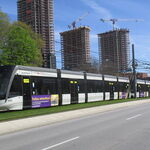crs1026
Superstar
I can't comment on VIA's relationship with CN (other than that it is already much more cooperative and constructive than certain "passenger rail advocates" let it appear), but I think we can agree that having a dedicated passenger corridor linking VIA's three busiest stations will alter the power relation with its most important host railroad...
The relationship gets badmouthed, I agree. I'm sure it's fundamentally businesslike and respectful. Nevertheless, that pessimism may, unfortunately, accurately predict business outcomes. CN is not unprincipled, but on any given day its operational people will put CN's business interests ahead of VIA's, to the extent that the service agreements permit. That's their job, after all. As will CN's lawyers when agreements are negotiated.
The issue for Kingston and other Lakeshore communities is whether that relationship gives appropriate consideration to their interests, given that there is no competing rail line that local rail service can be moved to, as is being accomplished via HFR for through service.
As far as I remember only P42 locomotives and LRC cars are allowed to reach 100 mph and there are hardly any corridor trains which are formed by just these two fleet types, but anyways, the more often Lakeshore services stop, the less the top speed would matter anyways, even if CN were to downgrade the tracks to Track Class four (i.e. 80 mph for passenger trains).
That's an interesting point. My knee-jerk reaction as a demanding spectator is, why isn't VIA configuring exclusively around 100 mph (the Challengers may lead to this) and then squeezing every possible second out of its timings?
They did just so, actually, back when the Metropolitan was conceived. Didn't last.
If it turns out that due to other considerations, (such as freight interference, dispatching through crossovers, slow orders, etc) that 100 mph capability just can't be leveraged, well that really is something my mindset just hasn't processed.
In poker, if you are trying to build a flush, you may have to discard your Aces in other suits. It just feels wrong, but it may have its reasons and its rewards.
Similarly, I don't see CN going down to single-track anywhere along the Kingston Sub, as it would be impossible to do so with drastic impacts on their own freight operations. Freight traffic on the Kingston Sub is much more intense than on the Winchester/Belleville Subs and than passenger traffic that eliminating some of the only 10-12 passenger trains per day between Brockville and Coteau will barely make a difference...
One can be certain that the finance side of the business will point to the extra capitalization on this line, relative to CN's busier single track lines handling equal ton-miles. That certainly was my experience about managing capital. And railway management is pretty ruthless about forcing cuts to extract excess capital. I have too much respect for CN as a business to believe they don't work this way.
If VIA is paying CN enough for that excess capitalisation, it may be moot for now. But if VIA runs fewer trains, presumably paying much less, the financial considerations will prevail. In that equation, taking track out of service is a very likely scenario.
Freight trains on the Kingston Sub are much shorter, faster and more frequent than out west - and I would expect CN to have very good reasons for operating in that way...
I really have to push back on this statement...... I believe it's factually incorrect. CN went to DPU on the Kingston Sub long before they did west of Toronto. A couple of the intermodal land barges from the west turn left at Doncaster and continue on to Montreal unaltered, as do grain and other unit trains. A key operational constraint CN experiences on the Kingston is the need to cross over VIA trains around long freights - the train handling required to slow a freight to crossover speed and the time required for a long freight to cross over and clear is unacceptable. So VIA has to be the one that slows down and crosses over. Trains on the Kingston Sub are every bit as long and heavy as elsewhere.
I don't mind having opinions, I'm just getting tired of unsubstantiated speculation presented as "this is going to happen"...
Touche. Perhaps some of us need a "we're just specators in the bleachers" disclaimer at the bottom of our posts.
Having said that, for most of my career I was the "what might go wrong" guy rather than the "let's all get on the bandwagon and shout rah-rah" guy. It worked for me.
And I think it is fair to articulate strong belief of probability. A lawyer friend recently lamented that people use the terms "shall, will, and may" interchangeably and incorrectly. Is there a single word that means "can't say for certainty, but pretty damn likely, if you ask me"?
In absence of the necessity to serve the primary markets, which will shift the focus from aggressive trip times to increased connectivity between the various cities along the Lakeshore. Therefore, average speed will be lower, which will naturally decrease friction between passenger and freight operations (by decreasing their speed differential).
Respectfully, this is the paradigm that resurfaces over and over again through the decades with respect to VIA service...."a few more minutes travel time won't hurt anything.....". What other business lets itself think this way? One would expect that VIA would insist on and articulate its vision of how the service can be improved.
For Kingston-Lakeshore, the limitations of the relationship with CN need to be acknowledged but not celebrated or baked into planning. Limiting service on the Lakeshore may be an unavoidable tradeoff in the push for HFR, but I would not represent it as an improvement or even status quo. There must be an ability to grow that service.
- Paul
Last edited:





